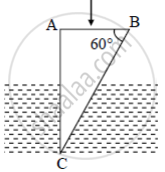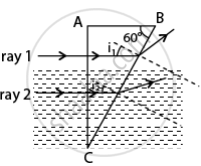Advertisements
Advertisements
Question
(a) A ray of light is incident normally on the face AB of a right-angled glass prism of refractive index aμg 1.5. The prism is partly immersed in a liquid of an unknown refractive index. Find the value of the refractive index of the liquid so that the ray grazes along the face BC after refraction through the prism.
(b) Trace the path of the rays if it were incident normally on the face AC.

Solution
(a)

Given the refractive index of prism μg= 1.5 the ray will grazes along the face BC when the angle of incidence i is equal to the critical angle for the glass and liquid interface here i = 60° (from the fig.)and sin i = `mu_"l"/mu_"g"`
`mu_"l" = mu_"g" sin "i"`
`mu_"l" = 1.5 sin 60°`
`mu_"l" = 1.3`
So the refractive index of the liquid is 1.3
(b)

The angle of incidence for ray 1 and ray 2 on face BC is equal to 30°For ray 1
The critical angle for glass-air interface is
`sin "i"_"c" = mu_"a"/mu_"g" = (1.3)/(1.5) = 0.866`
`"i"_"c" = 60°`
Now since the angle of incidence is smaller than the critical angle refraction will take place as shown in figure
APPEARS IN
RELATED QUESTIONS
Determine the change in wavelength of light during its passage from air to glass. If the refractive index of glass with respect to air is 1.5 and the frequency of light is 3.5 x 1014 Hz, find the wave number of light in glass.
[Velocity of light in air c = 3 x 108 m/s]
Explain refraction of light on the basis of wave theory. Hence prove the laws of refraction
At point A on the earth's surface the angle of dip, d = +25°. At a point Bon the earth's surface the angle of dip, d = −25°. We can interpret that
A wavefront AB passing through a system C emerges as DE. The system C could be:

Which of the following is conserved when light wave interfere?
Light travel faster in air than in glass according to
A Prism has reflecting angle of 60° when a ray is incident at 50° it suffer minimum deviation (Sm). The value of Sm is
If the critical angle for total internal reflecting from medium to vacuum is 30, the velocity of light n the medium is
A piano convex lens is made of refractive index 1.6. The radius of curvature of the curved surface is 60 cm. The focal length of the lens is
